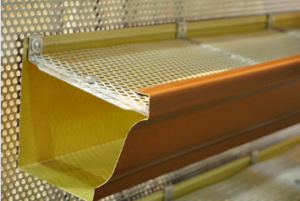Gutter protection keeps debris out of gutters, minimising clogging and increasing water flow to ensure foundation protection. It may also help avoid basement flooding and unsightly water streaks on exterior walls.
 DIY gutter protection manual may include installing gutter guards yourself. But be aware of potential dangers when working at height.
DIY gutter protection manual may include installing gutter guards yourself. But be aware of potential dangers when working at height.
Mesh Panels
Woven mesh panels provide an effective means of protecting gutters. Crafted from sturdy material, they create a secure barrier to stop debris, such as leaves, from entering your system. Plus, they help prevent fires from spreading from flying embers from bushfires or barbeques!
Mesh solutions can also be economical to protect gutters at home since they tend to be far cheaper than more premium solutions while offering the same security and functionality. It is particularly true if you select one with attachment points on the guttering instead of sitting directly on the roof.
As with foam inserts, mesh solutions can help keep debris out of your guttering system. Like their foam counterparts, mesh solutions create a flat level that serves as a defence against debris while allowing rainwater through small perforated holes. Unfortunately, these solutions aren’t always the most durable; you will likely need to clear away debris regularly from their perforated holes, which may block off. Furthermore, mesh solutions may become damaged from exposure to weather elements over time.
Brush Gutter Guards
Gutter guards are an efficient way to remove debris from gutters and reduce cleaning. They allow rainwater to move more freely away from homes while helping prevent overflow and foundation damage. Homeowners can save money and time when installing their gutter guard system by taking DIY gutter protection manual installation projects.
DIY gutter guards can be found online at hardware and home improvement stores. There is an assortment of styles available ranging from screens to foam inserts to brush guards made of aluminium, stainless steel or plastic materials; some clip on while others require screws or nails for installation.
Screen gutter guards resemble wire fencing or mesh and are the most commonly used DIY option. They sit atop your gutter with small holes that let water through while blocking leaves, pine needles and other debris from entering it. However, maintenance costs still exist as you must climb a ladder several times yearly to clear away debris and ensure your guards work effectively.
Brush gutter guards resemble screen gutter covers, featuring a centipede-like design to filter out large debris while allowing water to pass through. Easy to manipulate and cut using a utility knife or box cutter, brush gutter guards make the perfect DIY option.
Foam Inserts
Gutter inserts may seem like the underdog of gutter guard options, but they could be one of your best DIY protection solutions. They are less costly than many other options and provide good coverage.
These gutter guards are designed to keep out large debris while allowing rainwater to enter the gutters and flow freely. Made from various materials like plastics or metals, some models also come coated in UV-protective material to safeguard roofs and gutters against harsh sunlight.
Foam gutter guards can be an excellent solution for homeowners living in areas that experience frequent dust accumulation on their roof, falling pine needles or small debris accumulation. Unfortunately, they can become problematic in locations with heavy winds as the foam fills with silt from washing off roof surfaces, clogging gutters and slowing their ability to take in and carry rainwater.
Foam gutter guards constructed from polyethylene anti-static foam with semi-vel lamination are often the highest quality options. This material is lightweight yet sturdy enough to withstand time while remaining easy to cut with CNC machines for custom foam inserts in display and sales cases.
Plastic Gutter Guards
Plastic gutter covers offer easy home improvement installation without the hassle of foam and brush versions and are readily available from home improvement stores. While relatively cheap, they lack the durability of higher-grade gutter guards – warping quickly in high temperatures and becoming brittle over time due to UV radiation exposure.
As with other DIY solutions, these covers sit atop existing gutters and resemble screens with small holes that allow water to flow freely while keeping out debris such as pine needles, leaves and twigs. However, regular removal and cleaning are necessary to maintain optimal water flow; to do this effectively, a garden hose with high-pressure attachments may help dislodge any clogged materials and keep the proper flow going.